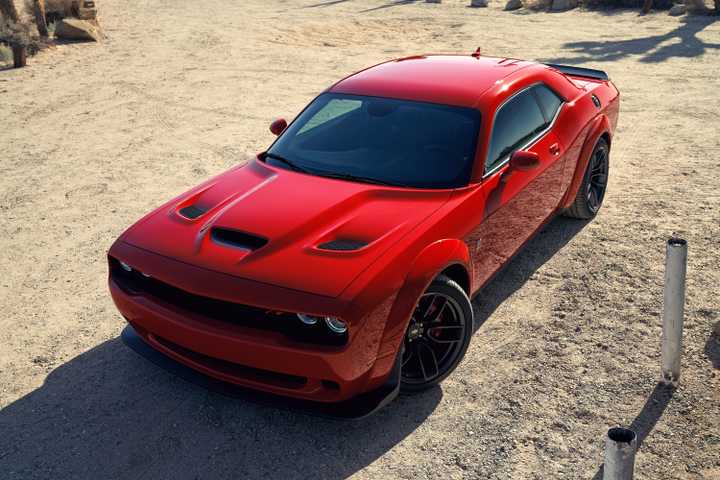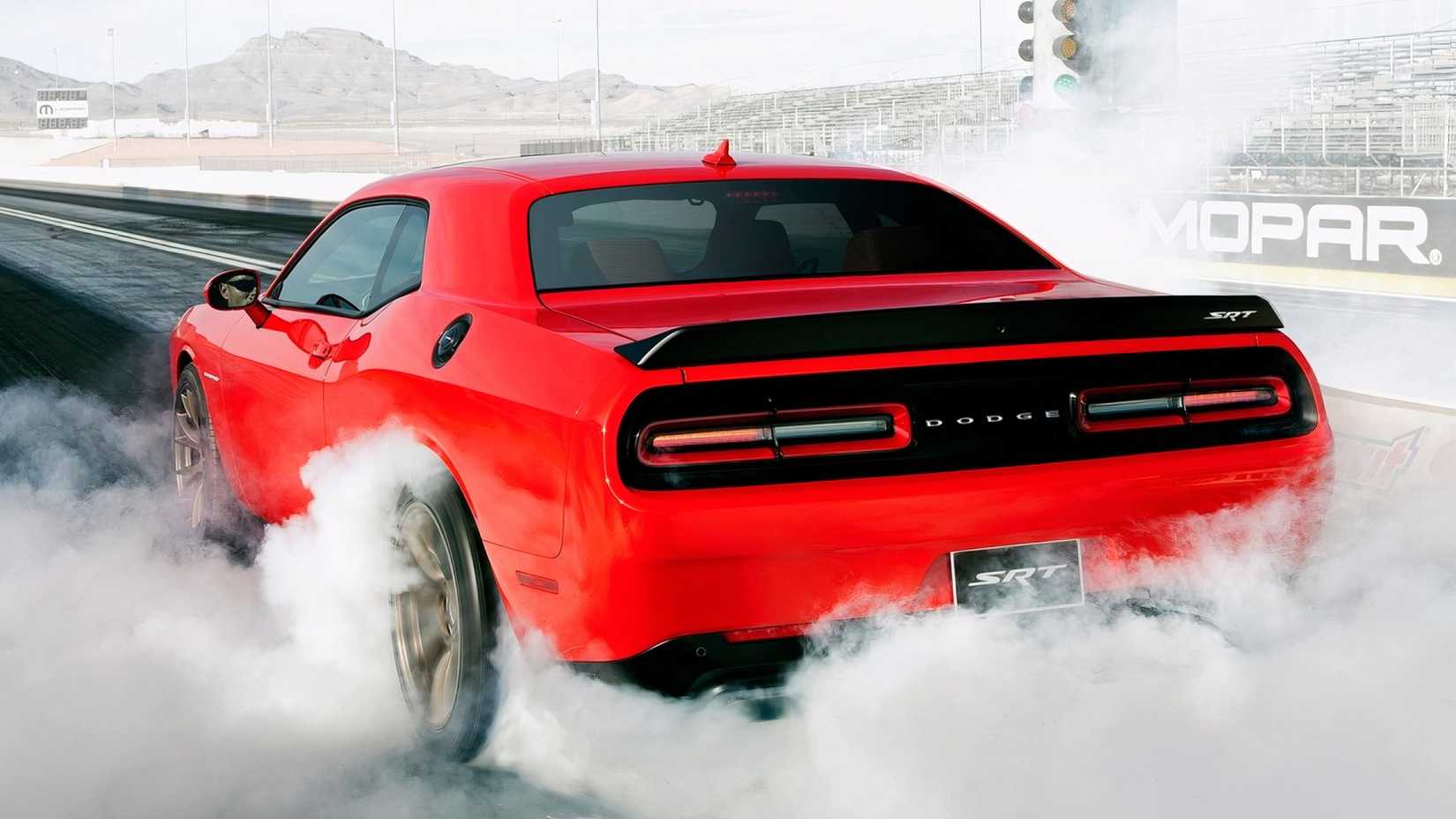When the 1980 AMC Eagle became the first passenger car with all-wheel drive, it was some radical technology, but it has since become not only commonplace but expected in certain classes of vehicles. Consumers demand AWD in sports sedans, crossovers, hybrids, and even high-end sports cars, with its absence as an option being a big thumbs down in automotive press reviews. One segment that never caught the AWD bug is muscle cars, which have remained relatively unchanged since their inception in 1964 as powerful rear-wheel-drive V-8 coupes.


- Base Trim Engine
-
3.6L V6 Gas
- Base Trim Transmission
-
8-Speed Automatic
- Base Trim Drivetrain
-
Rear-Wheel Drive
- Base Trim Horsepower
-
305 hp
- Base Trim Torque
-
268 lb-ft @ 4800 rpm
- Fuel Economy
-
19/30 MPG
- Make
-
Dodge
- Model
-
Challenger
- Segment
-
Full-Size Coupe
It kind of makes sense for muscle cars to have power at all four corners, if, for nothing else, really clean launches. Many EV hypercars are AWD, and they can rip off sub-three-second 0–60 times, so if something like a Dodge Charger SRT Hellcat with 700+ horsepower had two more wheels gripping, it would presumably have had quicker acceleration. The AWD Hellcat never happened, but Dodge actually did sell a muscle car with four powered wheels that most people either forgot about or never knew in the first place. For the final seven years of its life, the Challenger had an AWD trim that showed the driveline’s potential for muscular rides.
To give you the most up-to-date and accurate information possible, the data used to compile this article was sourced from various manufacturers and other authoritative sources, including Stellantis and J.D. Power.
The Unlikely AWD Dodge Challenger GT
Chrysler introduced all-wheel drive for the 300 in 2005 because any serious luxury sedan needed that option. The Dodge Charger picked up AWD for the 2007 model year, and while it was considered a muscle car, it had four doors and was technically a performance sedan, which again requires an optional couple of extra powered wheels. The Dodge Challenger, however, was pure American muscle with two doors and some insane engines to choose from, so it initially didn’t get in on the Mopar AWD campaign.
Then, in 2017, Dodge decided to give it a try, and the Challenger GT was unleashed with all-wheel drive. It’s impossible to say that this car made a splash because most people, to this day, have no idea the Challenger had an AWD trim, and probably are even ignorant of the similarly equipped Charger. This V-6, 3.6-liter Pentastar mill made 303 horses and 268 pound-feet of torque. Power was routed to all wheels via an eight-speed automatic transmission. Car and Driver noted that the car could sprint to 60 mph from a standstill in 6.3 seconds, to a quarter-mile in 14.8 seconds, and a top speed of 131 mph.
There are absolutely no numbers available as to how many Challenger GTs were sold, but just the fact that it is such an obscure trim points to the likelihood that it wasn’t super-popular. Maybe the biggest thing that kept the Challenger GT from being a big seller is that it was limited to a V-6 engine. An 808-horsepower AWD Challenger Demon would have been completely awesome, but six naturally aspirated cylinders are pretty meh. In reality, the GT’s 303-horsepower V-6 wasn’t bad and gave the car better-than-average acceleration, but it lacked the ferocious launch power of a modern muscle car. That competent power, combined with all-wheel drive, did, however, make for a great all-climate ride, which looked really cool.
There Exists Some Legitimate V-6 Muscle
Traditionally, a muscle car is defined as an American-made intermediate two-door coupe with a big honkin’ V-8, so the Challenger GT’s V-6 seems to exclude it from the group, but membership requirements have changed. The 1987 Buick GNX and 1989 Pontiac Trans Am 20th Anniversary Edition both packed turbocharged six-cylinder engines that rocketed them to quarter-mile ETs in the low 13s.
The modern Camaro, Challenger, and Charger all have V-6 options, yet they are somehow still muscle cars. Even the Mustang’s base model comes standard with a turbo-four, and literally nobody has ever complained that its 300+ horsepower isn’t muscular enough. Muscle has changed since the Golden Age and is now more of an attitude than a rigid set of parameters.
V-8 Hemi-Powered AWD Challenger That Never Was
The Charger AWD cars were actually available with a 5.7-liter Hemi V-8 from 2007-2014, except in 2011 when all-wheel drive took a hiatus. The Challenger GT almost got a Hemi V-8, too, but for whatever reason, Dodge pulled the plug on that idea. Debuting at the 2015 SEMA show in Las Vegas, the AWD Challenger GT concept car, based on the R/T Scat Pack, had a 5.7-liter Hemi under the hood. The response was extremely positive, with fans clamoring for a powerful all-wheel-drive muscle car, but when Dodge put it into production in 2017, it only had a 3.6-liter V-6, leading to relative indifference. Clearly, Dodge missed an opportunity by not including the Hemi as an option for the GT, but what’s done is done, including the Challenger, which was discontinued in 2023.
Rebooted Challenger Was A True Superstar
The OG Challenger was arguably one of the greatest rides from the Golden Age of American muscle, but its initial run was all too brief. While not exactly a one-hit wonder, it realistically only charted twice, kind of like Golden Earring with 1973’s “Radar Love” and 1982’s “Twilight Zone.” Launched in 1970, the Challenger was a massive hit, getting a little help from the white R/T in the classic chase film Vanishing Point, and followed up with a strong sophomore year in ’71, but after that, it fell off the map before getting the boot in 1974. Dodge slapped the Challenger name on some badge-engineered Mitsubishis in the late 1970s and early 1980s, but they were the furthest thing away from the muscular glory of the original.
The rebooted Charger was such a success that Dodge knew it had a window to bring the Challenger back as well. While the Charger bore little resemblance to the 1968-1970 muscle cars that defined the classic era, the new Challenger was a perfect update. With a body style resembling the killer first-gen, the 2009 Challenger added some modern flair to the retro design for a sexy, aggressive neo-classic. Just like the resurrected Charger, it was a massive hit with fans who had been waiting decades for a real Hemi-powered Challenger. It also marked the official beginning of the Modern Age of American Muscle as its runaway success caused Chevrolet to relaunch the Camaro in 2010.
Is this the most composed sports car we’ve ever driven? Not by a long shot. But wrestling with a 485-hp V8 and a tough-as-nails Tremec manual transmission is its own kind of fun. All of the controls are heavy and provide the same satisfaction of bashing a nail down with your boot heel because a hammer wasn’t available.
– Jared Rosenholtz, CarBuzz journalist, testing the Challenger Swinger Edition
The Insurmountable Challenger Hellcat
Like the classic era, the modern muscle car age included a horsepower war between the automakers, which was a complete thrill for enthusiasts. In 2015, Dodge fired the first shot in this conflict with the 6.2-liter supercharged Hemi Hellcat V-8, which initially cranked out 707 horsepower. Later tweaks got this monster engine up to 807 ponies, which made for some terrifyingly awesome acceleration. A 2015 Charger SRT Hellcat could blaze a quarter-mile in 11.2 seconds, while a 2023 SRT Hellcat Redeye Widebody smoked it in just 10.8 seconds. As mentioned before, a car like this would have been so much more badass with all-wheel drive, but sadly, it was never meant to be.
Challenger Demon 170 Unleashed All Hell
Dodge won the modern horsepower wars with the 808 pony-pumping 2018 Challenger SRT Demon, and then just to rub it in, opened a portal to Hell with the 2023 SRT Demon 170. Unlike the Hellcat, in which we speculated an AWD version would have been great, there’s no reason why this 1,025-horsepower beast would have benefited from a couple of extra powered wheels. It doesn’t seem necessary for AWD when those front wheels are up in the air on launch, and it would definitely take some torque away from the back wheels, resulting in slower acceleration. With a 0-60 time of 1.66 seconds and a quarter-mile of 8.91 seconds at 151.17 MPH, the Demon 170 doesn’t need any additional quickness.
The AWD Challenger GT Used Market
The Challenger GT AWD isn’t a collectible like the Hellcat or Demon, so there aren’t any banging auction sales to report on, but in a way, that’s good, because it is a solidly cool ride that is affordable on the used market. In 2017, the GT had an MSRP of $33,395 and, according to J.D. Power, the average price paid for one now is under $20,000. Even a 2023 model, which is practically brand new, sells on average for almost six grand under its original sticker price. While not as mindblowing as the supercharged V-8s or even the 392 Hemis, the GT isn’t exactly a slug, and it comes with AWD for a much more budget-friendly price.
The AWD Challenger GT’s average price for the 2017 model retails at $19,450, $21,373 for the 2018 model, $22,148 for the 2019 model, $23,998 for the 2020 Dodge, $27,873 for the 2021 model, $33,023 for the 2022 model, and $33,548 for the 2023 model.
The Challenger GT has about the same power as an entry-level Mustang, which we’ve already discussed is pretty damn good, plus it kicks ass in the snow and rain. Additionally, Mopar aficionados and non-Mustang fanboys alike would agree that the Challenger’s styling is ten times more badass than the Ford. A killer-looking muscle car with decent power that laughs at inclement weather and won’t break the bank is a winner in almost everyone’s book. The only real challenge (pun intended) in buying a used Challenger GT is finding one. They weren’t produced in large volumes, so it will take some legwork to turn up the perfect used car, but it can be done with perseverance.
The Dodge AWD Future May Deliver The Goods
The Challenger GT AWD is too obscure to have made an impact on the public, but it left a legacy nonetheless. It showed Dodge the viability of an all-wheel-drive muscle car and, more importantly, the need for one with a little more oomph. The Challenger, as well as the ICE V-8 Charger, were discontinued in 2023, replaced by the Charger Daytona EV, and we could rant for hours about the wisdom of that, but the point is that it comes with AWD. The Scat Pack trim features dual electric motors that generate up to 670 horsepower and 627 pound-feet of torque, distributed to all four wheels, resulting in an 11-second car.
There is also a gas-powered version of the Daytona known as the Sixpack, possibly stylized as SIX PACK, which is allegedly going on sale any day now. With a 3.0-liter twin-turbo inline-six that makes up to 550 horsepower, this is more powerful than a 392 Hemi, and reportedly, AWD is standard. It is also rumored that the AWD system can be disengaged to allow for RWD, which would be a pretty cool and useful feature. Granted, it just doesn’t feel like true Mopar muscle without a Hemi V-8, but there are also rumblings that the legendary wondermill is making a comeback as well. With that, there is the very real possibility that there could be an insane horsepower Hemi V-8 AWD, which should have been a thing all along.









